American Bald Eagles spotted on Lake Mead, Mohave
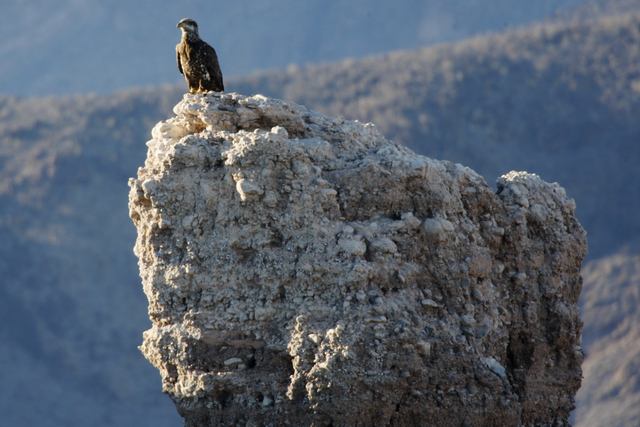
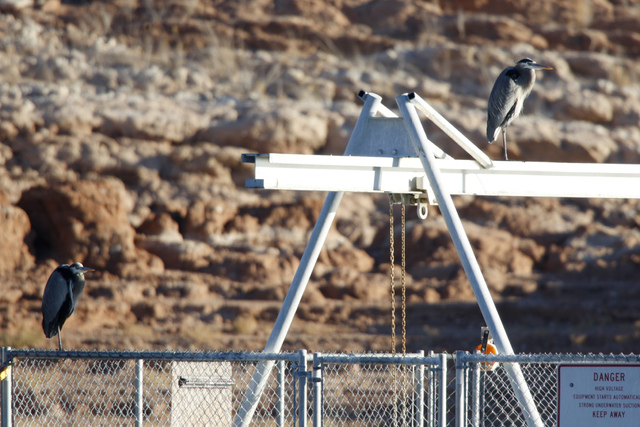

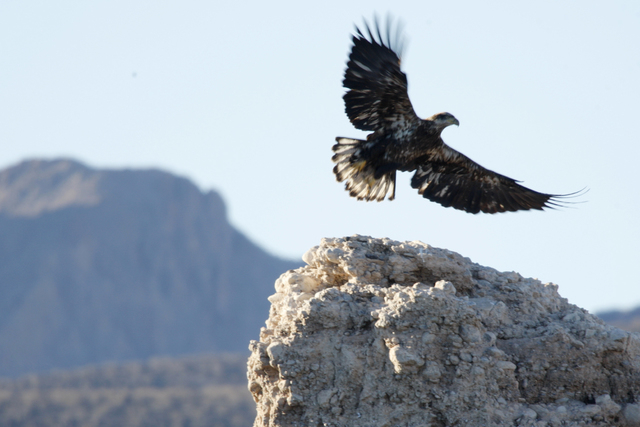
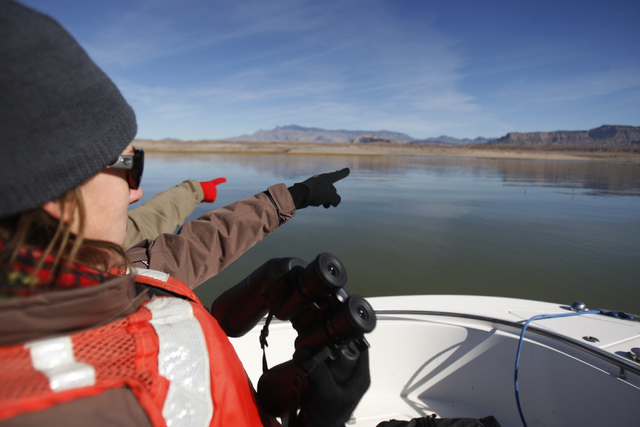
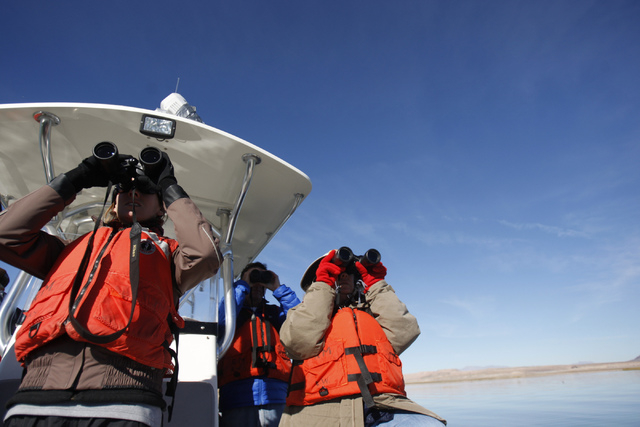



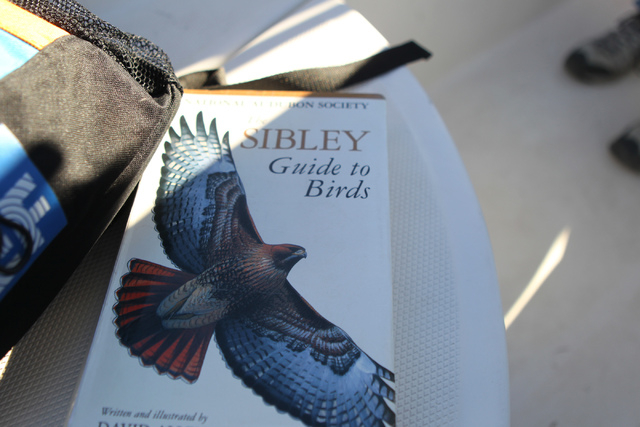


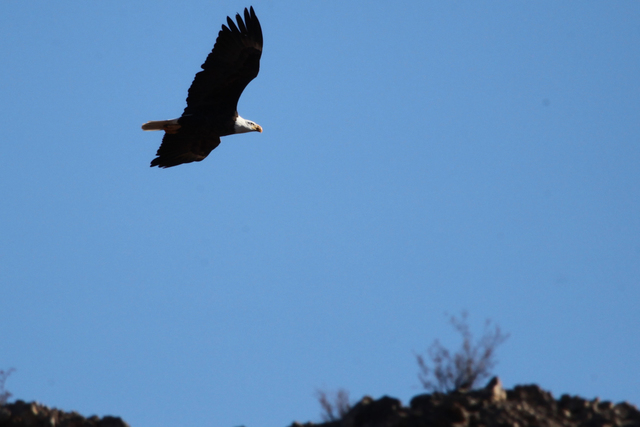



Peering through binoculars, Bob Haber watches in awe as a large dark bird with a snow-white head soars high above Lake Mead’s rocky shoreline.
Only a few of its feathers ruffle as it noses into a gentle breeze, holding a steady glide with its white tail and brownish-black wings that stretch more than 6 feet from tip-to-tip.
There is no doubt that this bird, an American bald eagle, is the boss.
In keeping with their reputation as king-and-queen birds of prey, the bald eagle and 17 others like it — adults and juveniles — sit in the throne at the top of the food chain on this chilly Tuesday morning at the lake’s Overton Arm.
“Bald eagles in particular are fascinating,” Haber says. “They’re just beautiful birds, especially in flight. They’re very bold. And when they sit and are looking out over the horizon for food, it’s just an amazing animal.”
Haber and his wife, Liz, are National Park Service volunteers who were among three dozen observers and biologists assigned to record raptors and wildlife sightings on lakes Mead and Mohave for the annual Jan. 6 nationwide Midwinter Bald Eagle Survey.
“I basically look for some sort of form that’s out of place,” Bob Haber explains. “I look at the top of ridges, the top of stones, the top of bushes and shrubs and look for a silhouette. Then I try to zero in and identify it more.”
From a distance while standing or perched on boulders, big bald eagles that weigh between 8 and 14 pounds, in the case of the larger females, look like fire hydrants poking from the shoreline.
Liz Haber said she feels fortunate to find eagles in their natural setting. Tuesday was her first crack at counting them for the survey.
“So often you just don’t see them. They’re there but you don’t notice them,” she said. “And to spend a day when that’s where your whole focus is, and then to see the variety of ages in the birds, and their health and what they’re doing is phenomenal.
“I was surprised we see as many as we actually do. You kind of take it for granted that you’re going to see eagles up in the mountains. And to see so many here at the lake level is quite a surprise,” she said.
BOUNCING BACK
This year, as in the past, there were a significant number of immature bald eagles, a sign that the bird’s reproduction cycle is on track. The trend for Lake Mead has been that more juvenile eagles migrate to the recreation area than the national average. Bald eagles reach maturity after about four years and they live about 10 years, although some have been documented to live 25 years or longer.
Also, based on an overlap of where eagles have been mapped in past years compared with this year, they tend to show up in about the same locations along the Overton Arm, perhaps because those perches offer good hunting habitats and vantage points on the shoreline, biologists believe.
The eagle-count tradition began in 1979 with the National Wildlife Federation. It is now carried out by the Army Corps of Engineers as a partner with the U.S. Geological Survey. The count has been used over three decades primarily to chart recovery of the bald eagle.
The nation’s iconic bird was declared an endangered species for much of the United States in 1967, before passage of the Endangered Species Act of 1973. Only 417 nesting pairs were known to exist in the contiguous 48 states in 1963, according to the National Wildlife Federation. The bald eagle’s decline was blamed in part on habitat loss. But pesticides that have since been banned played a role by contaminating prey the eagles ate, causing egg shells to thin and making adults sick and infertile.
They are still afforded protection under three federal laws: the Migratory Bird Treaty Act, the Lacey Act and the Bald and Golden Eagle Protection Act.
After the U.S. Fish and Wildlife Service documented an increase in the number of breeding pairs from 6,471 to 9,789 during a six-year span, they were delisted in 2007 as a threatened species under the Endangered Species Act. Nevertheless, biologists have continued to monitor their winter migration numbers at the Lake Mead National Recreation Area and other survey sites in the lower 48 states.
Ross Haley, a wildlife biologist for the Park Service, said the eagle survey is an important tool for checking the pulse of the ecosystem year after year to identify trends that might be affecting raptor numbers. At the same time, biologists can see how populations of other species such as ravens and invasive cattle and burros that have wandered from open ranges are affecting the environment.
“Bald eagles and other predatory birds are at the top of the food chain, and so they are a good indicator species of the health of the ecosystem,” Haley said.
“There are certain chemicals in the environment that are very persistent, and they accumulate as they move up the food chain. So these animals are very vulnerable to poisoning from chemicals that don’t break down very easily,” he said.
EAGLES GALORE
Typically, observer teams travel in boats at 15 mph or less on eight designated routes along the shorelines of lakes Mead and Mohave looking for eagles at the same time.
Strong winds gusting to 38 mph on Lake Mohave south of Hoover Dam precluded three boats from going out last week. Still, 91 bald eagles were recorded Tuesday on Lake Mead. Another 20 or so are expected to be counted this week when teams resume the survey on Lake Mohave, said Julia Mueller, a Park Service fish biologist who organized this year’s survey in Southern Nevada.
But this year’s count won’t come close to the record of 181 set during the 2011 survey.
Mueller said the preliminary tally “is not a drastic difference” considering that Lake Mead’s low level makes it difficult to look for eagles where they normally hang out near backwater areas at the north end of the lake along the Virgin and Muddy rivers.
“It’s not surprising. It really hasn’t been that cold yet,” she noted.
Except for the New Year’s Eve cold snap, this winter has had relatively warm temperatures that have kept much of the eagles’ hunting grounds north and northwest of Nevada from freezing over and triggering their migration south.
The Overton Arm at the north end of Lake Mead, for example, usually attracts more than 40 bald eagles to hunt for fish in the mammoth reservoir that holds an assortment of delights, from rainbow trout and striped bass to carp, largemouth bass and two kinds of shad. Eagles also sometimes pounce on a wayward coot or grebe or snatch some of the many green-winged teal or mallards that flock to the lake in the winter. They also eat small mammals.
Like Haley, Amanda Snodgrass, a botanist who recorded and mapped eagle sightings in the Overton Arm, said raptors that prey on fish and small animals attest to the ecosystem’s health.
“If we’re not seeing large numbers of predatory species, perhaps there’s something wrong in the environment,” she said.
“Maybe it’s chemical or there is some reason that those species are not appearing. We can kind of start to figure out maybe what’s going on, or where there are problems, if we need to try and figure something out or change things,” said Snodgrass, native seed manager at the recreation area. She works there through a fellowship with the nonprofit American Conservation Experience.
“Besides ecosystem monitoring, it’s kind of nice,” she said. “These are beautiful, majestic birds. They’re part of our heritage here in this country. It’s nice to be able to see them when you come and recreate on your public lands.”
Contact Keith Rogers at krogers@reviewjournal.com or 702-383-0308. Find him on Twitter: @KeithRogers2.












